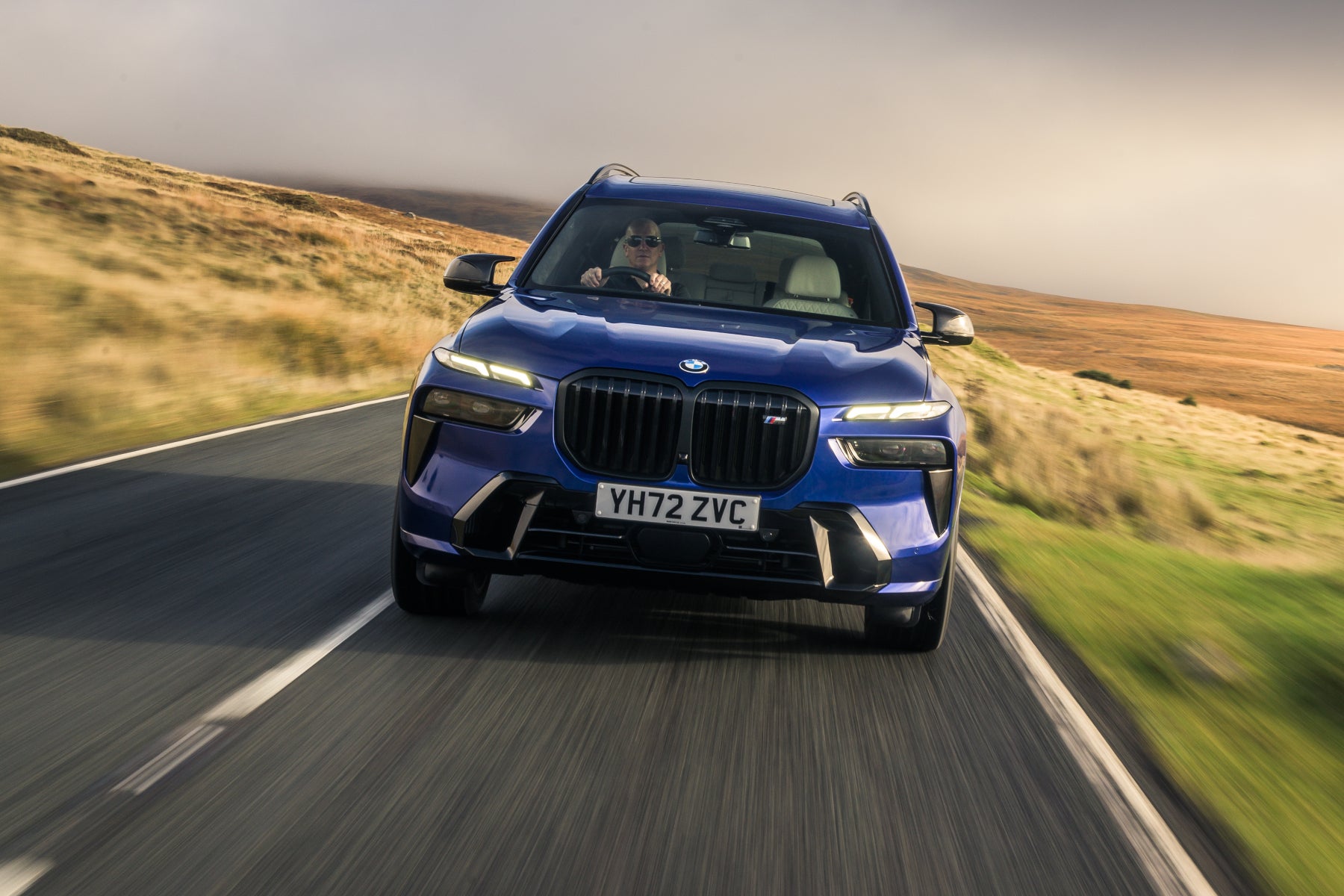BMW X7 Review 2024
Written by Lawrence Allan
Quick overview
Pros
- Massive, beautifully made cabin
- Arguably the best infotainment system in the business
- Refined and powerful engine range
Cons
- Not cheap, either to buy or to run
- Its size and weight is an issue on twisty roads
- Takes ages for the rear seats to fold electrically
Overall verdict on the BMW X7
"Enormous, brash and not one for shrinking violets, the BMW X7 is a car that definitely divides opinion. Most people will be happy with the smaller, cheaper X5, but if you must have the ultimate space and luxury in a BMW SUV it's a strong choice."
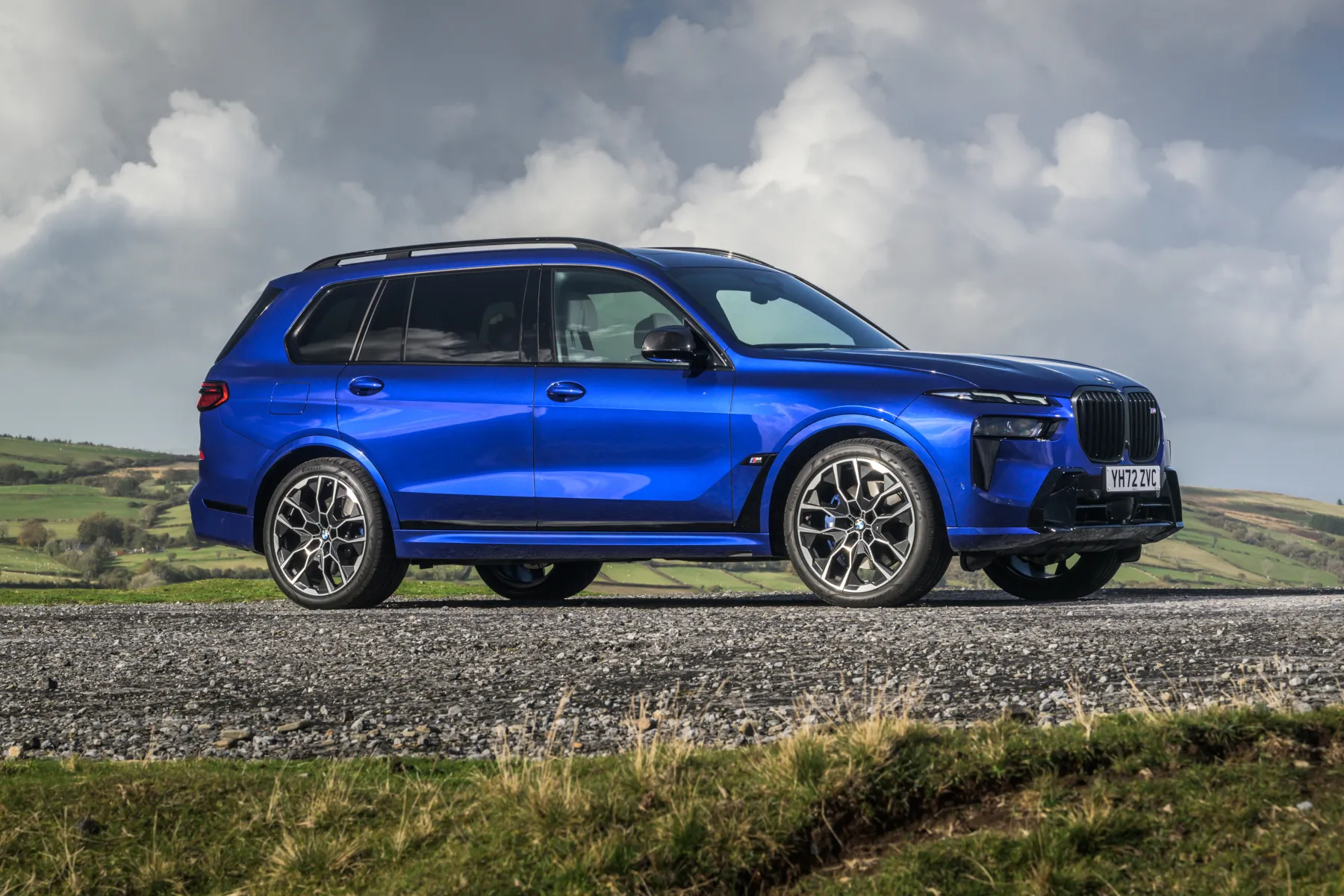
If you're a proponent of 'might is right' then you'll probably like the BMW X7. If you think a 5.2-metre long, 2600kg SUV is overkill on European roads, then you probably won't. But what matters here is whether it's a good car or not, and in this BMW X7 review we'll find out.
The seven-seat X7 is BMW's largest SUV on the market, and it's the flagship of the 'traditional' range alongside the similarly priced, smaller but more futuristic BMW iX electric SUV. It makes a good case for itself as one of the better big luxury SUVs on the market. And we do mean big. Even next to its massive competitors such as the Range Rover, the X7 looks like a complete beast thanks to its epic proportions and that gigantic grille at the front. This car is no wallflower, that’s for sure.
It's even more, erm, distinctive thanks to the 2022 facelift, which brought a redesigned front-end including new split-level headlights, plus some interior and technology upgrades. There's also a BMW X7 M60i topping the range with a potent (and ridiculously thirsty) twin-turbo V8, if that's your thing.
The BMW X7’s size brings more benefits than just on-road presence. All of the seven seats are surrounded by absolutely loads of space, making this one of the roomiest people-movers you’ll ever encounter. All the seats fold down and flip back up electrically, but while this makes the process very easy, it also makes it painfully slow. There's a split tailgate (both parts electrically operated, naturally) and a huge boot along with a standard-fit electrically-operated panoramic glass roof.
Trademark BMW quality is evident throughout, but the cabin has an even more luxurious feel than the smaller BMW X5, with sumptuous materials everywhere you look. There's plenty of cutting edge technology, too, including a fully-digital instrument cluster. That said, we don't think it looks or feels quite as special as a Range Rover.
The engine line-up comprises two petrols and a diesel, although they changed a bit in 2022. They’re all superb, with a brilliant mix of power and refinement, but for used buyers it’s the entry-level diesel, the 30d, that delivers the best combination of price, efficiency and performance for the majority of people. If you're buying a BMW X7 new, then sadly that engine's been ditched, so either the 40i petrol or 40d diesel would be our choice.
Of course, the sheer size and weight of the BMW X7 counts against it a bit on the road. As a long-distance cruiser it's superb, and it's less wallowy than you might think, but you're never going to enjoy trying to thread it down a tight, twisty road without knocking the mirrors off. It's also rather cumbersome around town. But in the context of big SUVs it's smooth, quiet and effortless.
If you're after a mammoth SUV, there are some brilliant choices, with very fine margins between them. However, the X7 makes a really strong case for itself, not least thanks to its refinement and performance along with its spacious, high-quality cabin.
Looking for a used car for sale? We've got 100s of BMW Approved Used Cars for Sale for you to choose from, including a wide range of BMW X7s models for sale.
Is the BMW X7 right for you?
Do you have lots and lots of cash? Do you have an absolutely enormous garage? Do you have a considerable number of children or friends? Do you like the finer things in life? If the answer to all of these questions is a resounding yes, then the BMW X7 could well be the car for you.
The sheer size of this car is one of its main attractions. Firstly, it gives the car massive visual impact, ensuring that you never go unnoticed, and it also gives a level of interior space that has the beating of most rivals.
Yes, it’s expensive, but no more so than many rivals, and the unbelievable quality on display, and the vast amount of luxury kit you get, mean that it feels like money well spent. If you need a single car that can do everything a well-heeled family can throw at it, the X7 is definitely worth a look.
What's the best BMW X7 model/engine to choose?
Of the four engines on offer on a used BMW X7, our pick would be the entry-level 30d diesel. Despite having the least power of the quartet, it’s still more than muscular enough to shift the enormous X7 around with a fair bit of intent. The 0-62mph dash takes just 7.0 seconds, and in a car the size that’s plenty. Yes, the rest are quicker, but they’re also pricier, thirstier and barely any more refined, less so in some cases.
BMW ditched the 30d diesel in 2022, so new buyers are now limited to more expensive options. The slightly faster 40d would be our choice, then, but the also excellent 40i petrol might appeal more these days given the gradual demise of diesel. That fall in popularity also saw BMW drop the M50d diesel model from the line-up.
Similarly, there’s no reason to upgrade from the basic trim, although we fully expect most buyers to pay the extra for the BMW X7 M Sport. This brings some visual upgrades inside and out (mainly out), and some beefier brakes, but pretty much nowt in the way of extra kit. It’s the same story with the range-topping M50i and M50d (now M60i since 2022) models. Each might get a fire-breathing engine and some extra bits of visual sparkle, but that’s it.
What other cars are similar to the BMW X7?
As a luxury seven-seat SUV, and an enormous one at that, the X7’s rivals come in the form of the Audi Q7, Mercedes-Benz GLS and Volvo XC90. A cheaper, but similarly spacious, option is also the Land Rover Discovery. You might also look at the Porsche Cayenne. However, arguably the car that the big BMW is gunning for most isn’t even a direct rival, and that’s the five-seat Range Rover.
The thing is, at this end of the market, the important thing isn’t how many seats a car has or how versatile it is, although those things are admittedly important. No, it’s about how special the car makes you feel, and what message it conveys to others about your success. That’s why these cars are so desirable, that’s why people pay so much for them, and that’s why the imperious X7 is aimed right down the Range Rover’s throat. Game on.
Comfort and design: BMW X7 interior
"A few updates have added to the BMW X7's high quality and high tech driving environment. It might be very similar to smaller BMW models but there's no doubting the finish, equipment and logical layout."
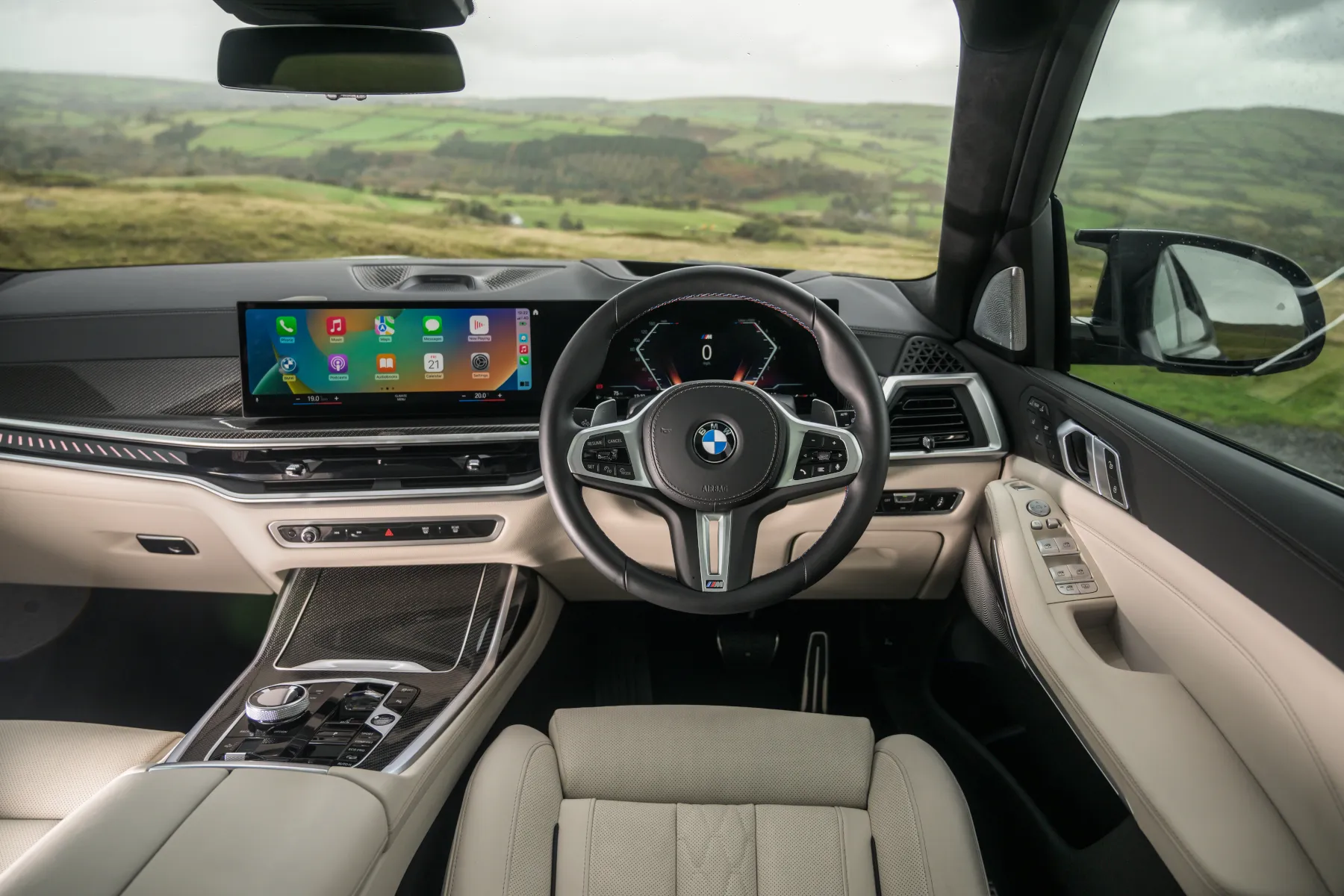
In terms of dashboard design, the BMW X7 is more-or-less identical to the smaller X5, bar a few revisions that came in 2022. That means there isn't a big mass of buttons, with most functions being operated through the excellent infotainment system that we’ll talk about in a moment, but those that remain are logically placed, well marked and big enough to hit at a glance.
It's not the most dazzling design in the class, sure, missing some of the lavishness a Range Rover offers and the opulence of a Mercedes-Benz GLS. But in terms of quality finish it exceeds both of those.
All versions have front seats that move in all sorts of ways electrically, so it’s easy to dial in your favoured driving position. The huge chairs are wonderfully supportive, too. You sit high up, just how SUV drivers like it, and your view in all directions is also pretty clear.
Despite that, trying to manoeuvre a car as enormous as the X7 isn’t easy, so of course the standard kit list includes sensors and cameras all over the place, plus a self-parking function.
In 2022 BMW redesigned the dash a bit to allow for a bigger, even more advanced infotainment setup - we'll come on to that below.
Quality and finish
The more time you spend poking and prodding the BMW X7, the more impressed you aware with the build quality. Everywhere you look, you’ll find materials, surfaces and finishes that simply ooze quality and class, and no matter how hard you hunt, you’ll fail to find a single part that falls below this incredibly high standard.
The design isn’t perhaps as showy and opulent as in some rivals, with simple features designed with ergonomics in mind and a look similar to that of 'lesser' BMWs, but it’ll match anything else in the class on sheer quality. The same goes for the standard of the assembly, which feels faultless from start to finish.
Stepping up from the Excellence trim to BMW X7 M Sport or M50/M60 trims bring a few interior differences like darker headlinings and different kick plates, but overall, all versions of the X7 feel as opulent as each other.
Infotainment: Touchscreen, USB, nav and stereo in the BMW X7
Effectively, all versions of the BMW X7 get the same infotainment system, and the good news is that it’s one of the best in the business. Importantly, it’s got the majority of important functionality covered. There’s navigation, Bluetooth, DAB radio, a WiFi hotspot, wireless phone charging and a whole bunch of clever connected services. Apple CarPlay is also supported, and although Android Auto wasn't initially it is now.
The 2022-on BMW X7 benefitted from a redesigned dash with slimmer air vents. More importantly, that allowed for a larger and more up-to-date infotainment screen. The screen size is a mammoth 14.9-inches, with an adjoining 12.3-inch screen in one panel.
What’s great about BMW's infotainment system, though, is that it’s so easy to use. Like every other system under the sun, it has touchscreen functionality, but what marks out the BMW is that it can also be operated using shortcut buttons and a scrolling wheel on the centre console, which is much simpler and much less distracting on the road. Despite the complexity of the system, it’s hugely intuitive to use, with logically arranged menus and easy-to-find features. The graphics are sharp and fast, so it’s nice to look at and slick to use. This really is as good as it gets.
The voice control functionality is also better than most, and if you so choose, you can also operate the system using gesture control; you basically wave your hand in front of the dashboard in a certain way to control certain functions. To use a popular phrase, gesture control is where BMW ‘jumped the shark’ with its infotainment, because it’s a completely pointless gimmick. The rest of the system, though, is wonderful.
Space and practicality: BMW X7 boot space
It's worth taking stock over just how big the BMW X7 is. It's huge. It measures more than five metres in length (5181mm to be precise), two metres wide (not including door mirrors) and 1.8 metres in height (or 1835mm if you're trying to squeeze it under a car park barrier).
You’d rightfully expect a seven-seater on the scale of the X7 to be hugely practical and versatile, and you won’t be disappointed by the X7. There’s a huge amount of space up front, and again in the middle row of seats, there’s a massive amount of headroom and legroom, allowing even tall passengers to stretch out luxuriously. The enormous width of the cabin, plus the flat rear floor, allows you to seat three across the rear bench in relative comfort, too, not something that all cars of even this size can achieve.
The third row of seats is also very roomy indeed, roomy enough for even tall adults to travel comfortably. In fact, the rearmost seats are some of the roomiest in the class, so if you need a posh team bus for your five-a-side team plus substitutes, this is it. Access is also good thanks to huge rear doors and a large gap between the seats to clamber through.
All of the seats behind the front ones can be raised or lowered - and in the case of the middle ones, slid and reclined - electrically. This has both positives and negatives. On the plus side, it’s very easy, but on the negative side, it’s very, very slow. If you’re trying to get lots of people into the car when it’s raining, you won’t want to be waiting around for the seat mechanisms to finish doing their thing. Your kids, meanwhile, will probably run off out of sheer boredom waiting to get in.
With all seven seats in place the BMW X7's boot can carry 326-litres of luggage – enough for a few shopping bags or a couple of carry-on cases, but about the same size as a small hatchback. However in five-seat mode the load area is massive at 750-litres.
The split tailgate arrangement also provides a handy shelf to make loading heavy items easier, or to act as a bench while removing muddy boots. Turn your X7 into a two-seater, and there’s enough room to carry a moderately sized sofa. All the chairs fold flat into the floor, leaving you with a flush load area, too.
BMW also offered the option of replacing the three middle seats with two individual chairs offering their own armrests and a huge range of electrical adjustment for extra luxury. Bear in mind, though, that if your car has these fitted, you won’t be able to fold these chairs down flat.
Handling and ride quality: What is the BMW X7 like to drive?
"Despite BMW’s ‘Ultimate Driving Machine’ tagline, you’re never going to get an SUV the size of the BMW X7 to handle like a sports car, so the engineers (rightly) decided to focus on comfort. And they’ve done a good job, too."
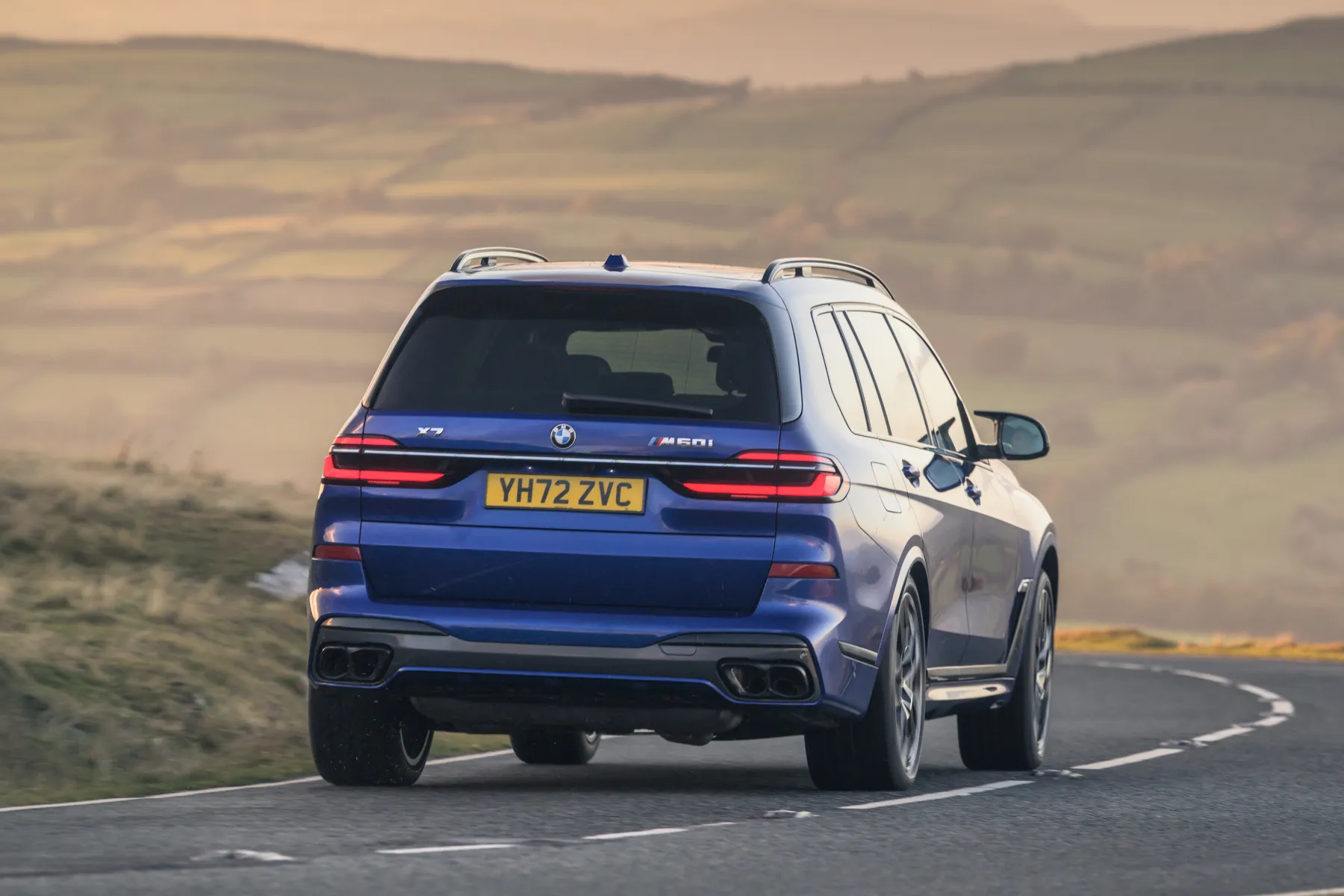
The BMW X7 pretty much pummels most bumps into submission, and the standard air suspension does a pretty good job of isolating you from the effects of bigger ones.
Perhaps we're being picky, but the ride isn't as consistent as we'd like. It floats along nicely the majority of the time, but sharper potholes and undulating surfaces cause it to shudder and wobble around a bit. It's not a dealbreaker, and generally speaking the X7 is a plush luxury SUV, but we're only judging it next to the immensely high standards of the Audi Q7.
Considering the size and weight of this car, it does a pretty decent job in the corners, too. Granted, it doesn't feel anything like as sporty and tied down as a BMW iX, but it doesn't wallow and list over like a cross-channel ferry in a storm either. We reckon the Audi Q7 might be more athletic still, however.
The steering is quick enough and nicely weighted, and if you regularly use your X7 in town, you might want to find an example with the optional four-wheel steering fitted. This turns the rear wheels in the same direction as the fronts at high speed to aid stability, and in the opposite direction at low speeds to aid manoeuvrability, and it’s really effective. Don't go thinking it'll make it a doddle to park and thread through city traffic, though, because it won't - this is still a massive, cumbersome car.
The BMW X7 M60i gets four-wheel steering as standard, but other than the massive 23-inch wheels it doesn't handle that much differently than the standard car. Those wheels do make more of a meal of really sharp bumps, but it's hardly uncomfortable.
What engines and gearboxes are available in the BMW X7?
For the used BMW X7 buyer, you have the choice of four engines; two diesel and two petrol. The starting point is the xDrive30d diesel, which is a 3.0-litre six-cylinder unit with 265PS. It has enough low- and mid-range muscle to get the huge X7 up to speed impressively quickly, and for a car of this size, it even has a surprisingly strong turn of speed on the move. It’s all you need in the X7, and that’s what makes it our favourite.
If you’re after even more pace, however, the M50d uses the same basic unit, but with four (yes, four) turbochargers to hike the power up to 400PS. It’s absolutely savage in the way it gets away from the mark cutting the 0-62mph dash from 7.0 seconds in the 30d to just 5.4 seconds. Fun, yes, but expensive and rather needless for most X7 buyers.
The entry-point for petrol buyers is the xDrive40i, a 3.0-litre six-cylinder turbo with 340PS. It’s a bit too thirsty to be our recommended engine, but it’s a very pleasant thing nonetheless. It’s really responsive, even at the bottom of the rev range, and as the revs rise, it punches properly hard. At the top of the range is the M50i, with its 530PS 4.4-litre V8.
In 2022 for the facelift, the BMW X7's engine range changed quite a bit. Our favourite 30d diesel bowed out because most well-heeled buyers wanted even more performance, so there's an xDrive40d six-cylinder diesel model with a punchy 352PS.
Diesel isn't the choice du jour for new car buyers, though, so we expect the BMW X7 xDrive40i petrol would be the most popular choice. Power is boosted over the old 40i engine up to a potent 381PS, and with 0-62mph coming up in 5.8 seconds we can't see why you need any more performance from a huge SUV like this. It's smooth and effortless when you want it to be, and makes a great noise when you don't.
Certainly the xDrive40i makes the new BMW X7 M60i look faintly ridiculous. Despite the name boost from 'M50i' to M60i it still puts out the same 530PS from its 4.4-litre twin-turbo V8, but the new engine is is mated to a mild-hybrid system to boost efficiency and responses. It's a bit of a monster, with 0-62mph coming up in 4.7 seconds and a burbling, hairy-chested soundtrack. But it's expensive and still pretty inefficient, as we'll come onto in a bit.
All cars come with a cracking eight-speed gearbox that swaps cogs pretty quickly and smoothly. There is a tiny delay when you really put your foot down, but it’s nowhere near as ponderous on that score as rivals such as the Audi Q7 and Range Rover.
Refinement and noise levels
All of the engines in the X7 do a great job of keeping your life civilised. Even the 30d engine goes about its business smoothly and quietly, and is even less intrusive than the equivalent units in the Audi Q7 and Range Rover. The 50d, meanwhile, is actually a bit noisier than its less powerful counterpart, but it’s still far from raucous.
The 40i petrol is even sweeter; whisper quiet at a steady cruise, but with a satisfying snarl if you choose to pick up the pace. Refinement is also top-drawer in other areas. Very little wind or road noise make it into the cabin, even at high speed, and you barely hear a peep from the suspension, even on relatively rough roads.
The post-facelift versions are basically the same on the refinement front (i.e. very good). The M60i model has more road noise from its huge wheels and tyres, but the engine is muted when you want it to be and makes a great V8 racket when you ask for it.
Safety equipment: How safe is the BMW X7?
All BMW X7s get the same basic suite of safety equipment, which we reckon is a good thing. It means that buyers of cheaper (in the very loosest sense of the word) versions aren’t penalised in this important area.
As well as a comprehensive suite of airbags and stability aids, the X7 comes with automatic emergency braking, lane departure warning, run-flat tyres, speed limit information, front and rear parking sensors with cameras, a self-parking function and cruise control with a braking function.
More is available from the options list in the form of the Driving Assistant Professional pack. This adds a vast suite of semi-autonomous functionality that helps the driver guide the car under certain circumstances.
MPG and fuel costs: What does a BMW X7 cost to run?
"You’d expect a car of the X7’s proportions to be a bit on the thirsty side, and you’d be right, although to be fair, it actually performs a little better than most rivals on this score. The M60i model is a bit silly, however."
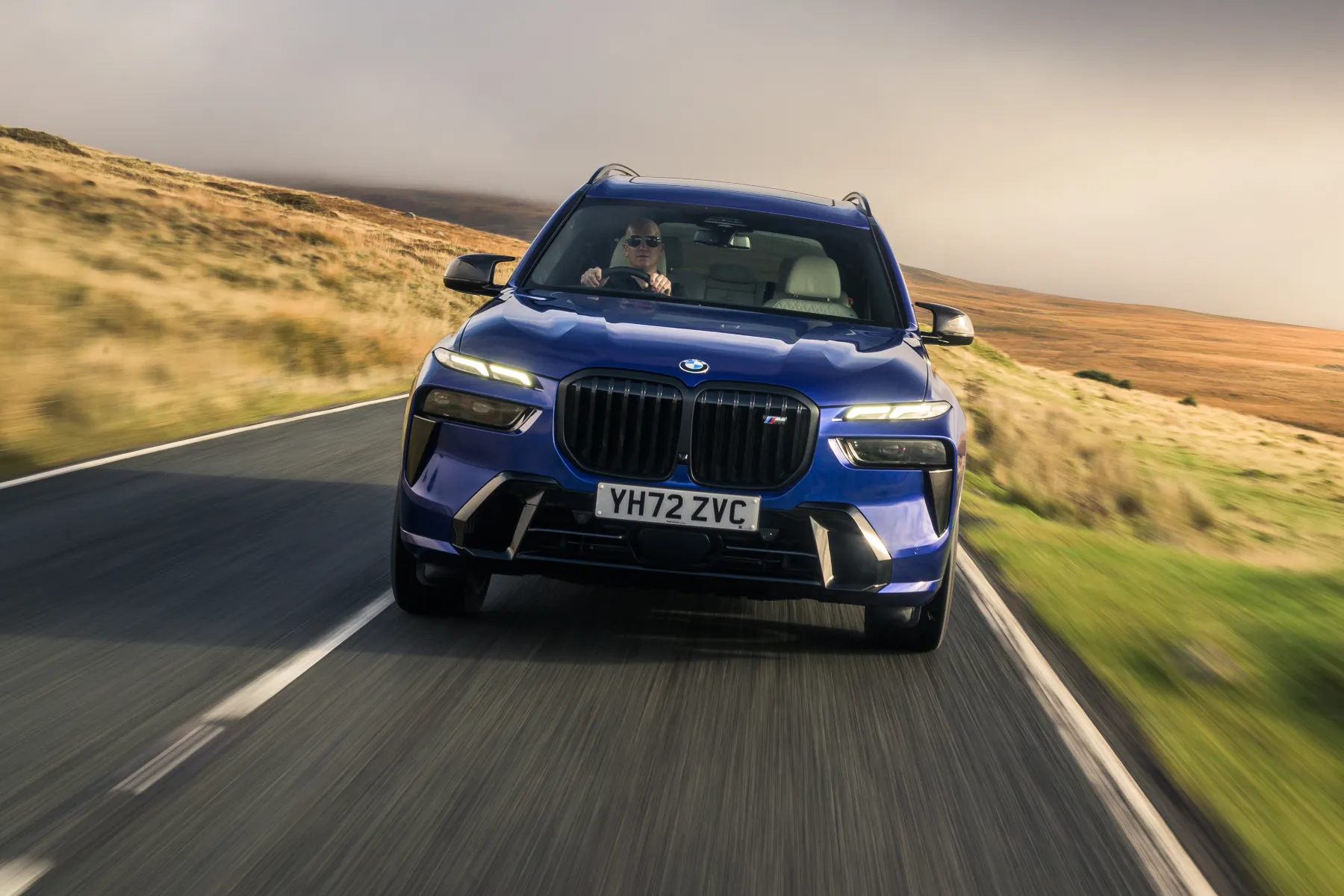
Officially the old X7 xDrive 30d diesel did up to 33.6mpg on the combined WLTP cycle, which is a realistic figure in the real-world. It's the most efficient of the used BMW X7s, and the one we'd pick.
In 2022, BMW added mild-hybrid tech to every model, meaning the more powerful X7 xDrive40d manages up to a claimed 36.2mpg. That's impressive given the performance on offer. The xDrive40i petrol manages a less remarkable 29.4mpg, but then that's big petrol SUVs for you.
Speaking of which, you'd have to be committed to speeding up global warming to go for the X7 M60i. Officially it'll manage 23.2mpg, which is bad in itself, but it gets worse if you use the performance.
How reliable is a BMW X7?
BMW scored 12th place out of 29 car manufacturers assessed in the most recent HonestJohn.co.uk Satisfaction Index. We've heard of very few common issues afflicting the BMW X7, while its engines are shared with a wide range of other (reliable) BMW models.
Insurance groups and costs
Easy one, this. All versions of the BMW X7 sit in group 50 for insurance. Which is the most expensive one there is. Which is a shame. But come on, are you really surprised? Yes, insurance costs will be high, but so will all other costs where the X7 is concerned. If you can afford to buy a car like this, then your annual insurance premium will probably be a drop in the well.
VED car tax: What is the annual road tax on a BMW X7?
When you buy a car as expensive as the BMW X7, you’d expect the government to take its cut, and it most certainly does. The good news is that used buyers will dodge the ‘showroom tax’ that buyers of new X7s will pay.
Road tax rates for the BMW X7 when new mean even the most efficient version will pay at least £1650 on top of the list price for the first year rate. The M60i sits in the highest band commanding an eye-watering £2745 extra. Oh, and you'll pay £490 a year on top of those for five years after that. Ouch.
Thankfully, due to the bizarrely straightforward way the used car tax system works, all versions will pay the same £190 a year flat rate after the five-year period.
How much should you be paying for a used BMW X7?
"Like all massive luxury SUVs, the BMW X7 is a fantastically expensive machine. However, buying used can draw the sting of this."
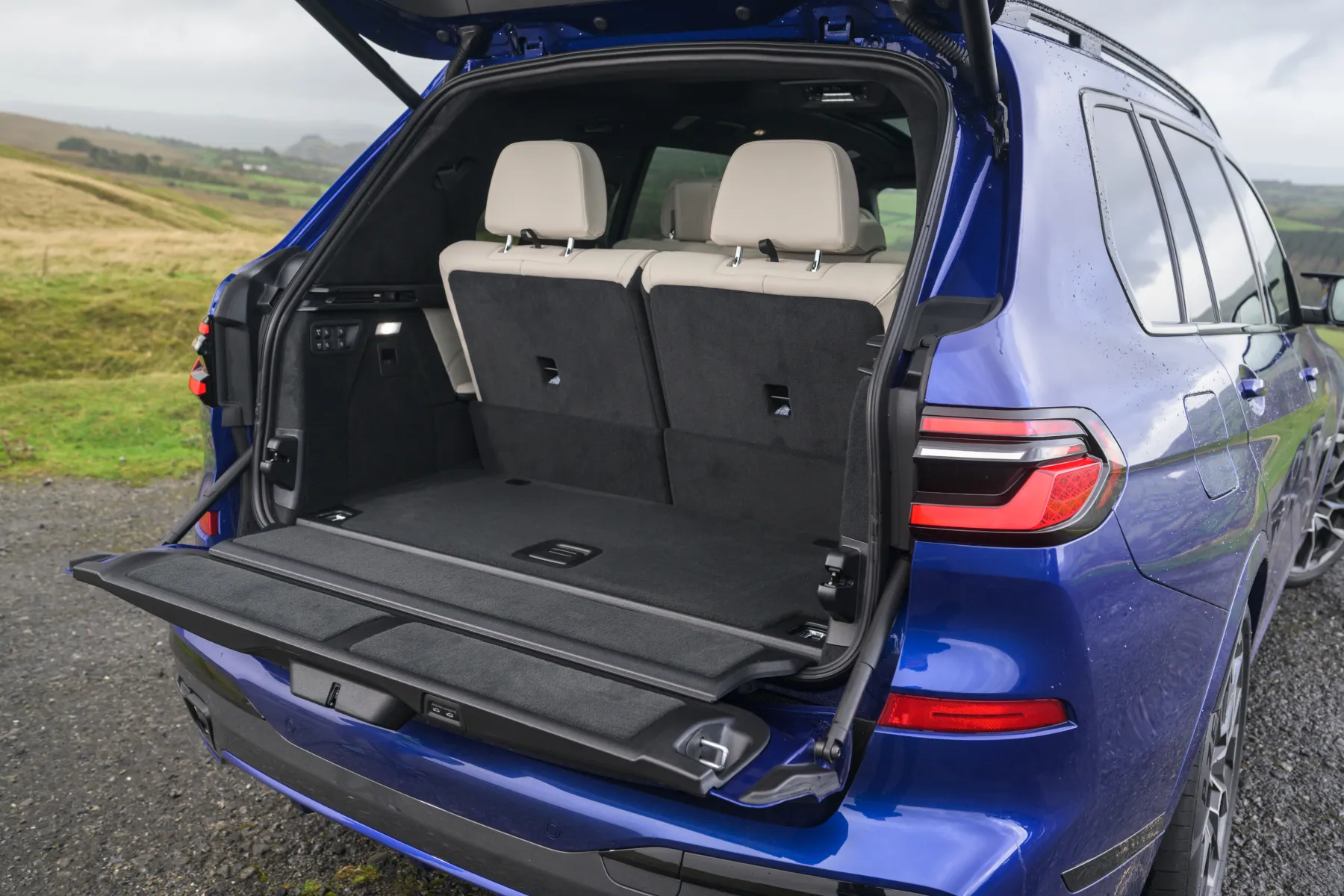
The BMW X7’s resale values are among the strongest in the class, but large luxury SUVs do still shed value quite considerably. We found a 2020 30d M Sport example with 32,000 miles on the clock for less than £48,000, but most are between £60k and £80k.
Trim levels and standard equipment
There’s very little that’s basic about the BMW X7 in its basic form. Aside from all the safety and infotainment kit we’ve already talked about, all X7s come with four-zone climate control, a panoramic roof, heated front and rear seats, soft-close doors, leather upholstery, ambient lighting and automatic lights and wipers. In this spec, BMW now calls this trim Excellence.
Aside from upgraded brakes, the step up to BMW X7 M Sport trim only really earns you aesthetic upgrades inside and out. Despite that, this will still probably be the best-selling trim.
It’s a similar story with the range-topping M models in 50i and 50d (or, from 2022, M60i) forms. Most of the difference are aesthetic ones, although you do get a performance differential and uprated Harman Kardon speakers. Plus, of course, these versions have even greater performance from their potent engines.
Ask the heycar experts: common questions
How much does a BMW X7 cost?
Is the BMW X7 a seven-seater?
Is the BMW X7 a luxury car?
Get our latest advice, news and offers
Keep me updated by email with the latest advice, news and offers from heycar.
By submitting you agree to our privacy policy
